
1. Negative
1.1. Larger pool of labour force for factory owners to choose from
1.1.1. Lower pay for workers
1.1.1.1. Poor working conditions
1.1.1.1.1. Child labor used
1.1.1.1.2. Workers mistreated
1.1.1.1.3. Lack of breaks
1.2. Growing population
1.2.1. High number of people moved to cities
1.2.1.1. Overcrowding
1.2.1.1.1. Poor standard of living
1.3. Creation more distinct different classes of people Eg. Upper class, middle class and lower class
1.3.1. The gaps between each class becomes wider, especially the upper and lower class.
1.3.2. Larger middle class can be observed
2. Positive
2.1. Increased wealth
2.1.1. Invention of new technology
2.1.1.1. Increased goods for export
2.1.1.1.1. More revenue for businessmen
2.1.1.2. Increased productivity of factories
2.1.1.2.1. Workers could make use of machines to work more efficiently
2.2. Population growth
2.2.1. Larger workforce
2.2.1.1. Caused by the agricultural revolution and other factors
2.2.2. Needed to sustain demands of workers from factories and businessmen
2.3. Modernized Europe
2.3.1. Increased economical activity
2.3.1.1. Britain's economy greatly improved, and it set the pace for the industrial revolution before all European countries and America.
2.3.2. Allowed increased integration of people (especially in cities)
2.3.2.1. People were forced from the countryside into the cities, and some even went to other countries such as America
2.3.3. Social mobility increased
2.3.3.1. People not so much judged on background, but on talent
2.3.3.1.1. As seen from even normal people inventing machines that made them rich
2.3.3.1.2. And growing middle class
